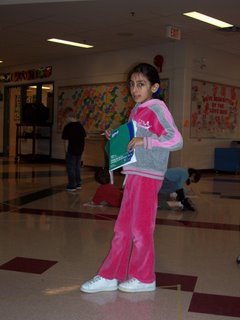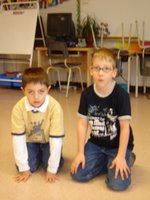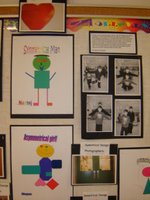
As part of our Social Studies curriculum, we have been looking closely at Atlantic Canada and the landscape. Here is how I approached teaching the landscape through the arts....
Lesson 1 : Introduction
Discussion/mapping of where Atlantic Canada. Students will do a KWL chart.
Lesson 2: First Impressions 
Teacher will print numerous pictures of Atlantic Canada.
Students walk around and observe pics. Students choose favorite pic. and stand by it, therefore, creating their work group. Using a sharpie and paper, students analyze the pic., writing down nouns and adjectives to describe what they see
Circle 5 nouns they feel most represent Atlantic Canada. As class, teacher lists nouns on chart paper.
Lesson 3: Inquiry into Atlantic Canada
Students rejoin group and ask questions based on their pictures
As a class compile questions and keep posted for reference throughout unit.

 Lesson 4: Oil Pastel
Lesson 4: Oil PastelTeach new medium: Oil pastels
Students are given B & W copy of their pic. and use pastels to color it in
Add any new nouns they noticed while doing this
Lesson 5: Descriptive Writing
Teach similes and do many examples 
Refer back to list of compiled nouns
Using google, students search for Atlantic Canada images and paste into PowerPoint
Write a simile to describe the image
Discuss role of font, balance, complimentary colors and animation
Record students reading their simile
Refer back to original pic. and write similes about the landscape

Lesson 6: The Bluenose Schooner and other boats
As a correlation to our science unit, "Boats and Buoyancy" we started to look at various types of boats, and the construction of boats. Students inquired about boats using library books, videos and the internet. Our conversations led us into talking about the Bluenose Schooner - and it's importance to Atlantic Canada. It led to an interesting discussion about the dime and the location of the Bluenose on it.
After learning about the various parts of a boat, students used charcoal pencils and a grid to redraw the Bluenose. Emphasis was put into the actual design of the schooner, and art techniques of shading.
Transportation of goods by water and land were discussed and students role played the movement of goods by different forms of transportation.
Lesson 7: The MicMac and Acadia
We brainstormed about different types of boats, and one that was discussed with the canoe. This led us into a look into how the Micmac used birchbark canoes to travel. Students used butcher tape to make a canoe replica. We talked about how the Micmac traveled down the St. Lawrence River and eventually encountered early settlers. Students renacted these first encounters.
Lesson 8: Early settlers and quilting through fractions
Recreation time for early settlers were discussed and it led into the study of quilting and quilting bees. Students had the oppotunity to look at quilts and identify patterns and designs. This led us into a discussion on fractions. Students later created fractional quilt squares using halves, thirds and quarters!
Lesson 9: Atlantic Puffin
 The students were excited to learn about the Atlantic Puffin. We read books about the Puffin, and listened to the Puffin on the internet. We looked at the work of George Seurat, who is a Pointilism artist. We talked about how we can convery shadow with dots. Students were given an outline of a Puffin and needed to use a Sharpie to shade in the Puffin. they turned out to be beautiful!
The students were excited to learn about the Atlantic Puffin. We read books about the Puffin, and listened to the Puffin on the internet. We looked at the work of George Seurat, who is a Pointilism artist. We talked about how we can convery shadow with dots. Students were given an outline of a Puffin and needed to use a Sharpie to shade in the Puffin. they turned out to be beautiful!
Lesson 10: Soundscape
This was really fun and involved a lot of creativity and collaboration for the students. We reviewed everything we had learned about the landscape of Atlantic Canada - rocks, fog horns, water, plants... We talked about what sounds they thought these features we would make (i.e. a rock may make a "plop") and then we discussed which of the features would be "loud" sounds and which would be "soft" sounds. I put a variety of instruments around the classroom and had students explore for at least a noisy 25 minutes with these instruments. We discussed "loud" and "soft" instruments. Students were then encouraged to become composers, creating a 20sec. soundscape about the landscape of Atlantic Canada. We had discussed how to create a clear beginning, middle and end - as well as having flow to their song. A truly fun and enriching experience!
Lesson 10: Conclusion
 We read and learned about the art of Ted Harrison. We discussed his use of lines and colors and simplistic detail. We talked about what things would represent Atlantic Canada.
We read and learned about the art of Ted Harrison. We discussed his use of lines and colors and simplistic detail. We talked about what things would represent Atlantic Canada.
As a final conclusion to our unit, we wrote a song to the tune of "Twinkle, Twinkle Little Star" entitled: "Lobster, Lobster on a Dish". The whole class wrote the first verse together, and then small groups wrote the additional verses. We taped our song and played it for the school. Here are the great lyrics!
Lobster, lobster on a dish,
I wonder if you’re a fish?
Under the sea so deep and blue,
And it looks like you are new,
Lighthouse, lighthouse shining bright,
Guiding fishermen through the night!
Beluga, White tail, Orca whales,
Dancing with their giant tails.
Dairy, dairy, dairy cows,
Give me some milk I need it now!
There are lots of rocks out here,
Crashing waves are coming near.
Market, market sells so fast,
We have really good food at last!
The water is blue just like you,
Whales swim and they are blue.
Schooners, schooner floating away,
Rocking back and forth each day!
Lobster, lobster on a dish,
I wonder if you’re a FISH!!










































